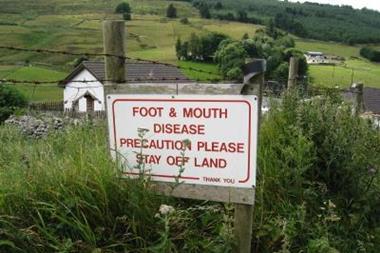Broker offers advice in latest health scare
Marsh has interestingly issued advice for businesses affected by the outbreak of Foot and Mouth Disease (FMD) among livestock in Surrey and those threatened by the spread of FMD across the UK.
The 2001 outbreak resulted in £3bn worth of direct costs to agriculture and £5bn worth of indirect costs to other sectors like tourism. The farming sector and related industries, such as haulage, food processing, tourism and exporting, should now focus on stopping the disease spreading and begin to apply the lessons learnt from 2001.
The key points Marsh identify are:
• Comprehensive contingency plans must be in place, exercised and co-ordinated.
• The farming industry must be made less vulnerable by reforms in industry practice, which in turn will minimise the wider impact of an outbreak of FMD.
• A high level of biosecurity is essential.
• Reaction should be with speed and certainty by applying well-rehearsed crisis management procedures.
Although the incidence of accidental release of biohazardous materials is generally extremely low and the treatment of biohazards is very tightly controlled in the UK. Given the nature of FMD and the fact it can be transmitted through the air, the key issue for biosecurity is to ensure it does not escape from the facility.
The UK currently has four biohazard levels for research facilities, with one being the lowest risk and four being the highest. The Pirbright facility is probably classed as a Level Three risk. Laboratory personnel in a Level Three facility have specific training in handling pathogenic and potentially lethal agents, and are supervised by experienced scientists.
All procedures involving the manipulation of infectious materials should be conducted within biological safety cabinets or other physical containment devices, and by personnel wearing suitable protective clothing and equipment.
Businesses, especially those in the agricultural or food-processing sectors, should be reviewing their biosecurity regimes and contingency plans in anticipation of the current FMD outbreak escalating. Depending on the outcome of the current investigation medical research and pharmaceutical companies may also need to undertake further reviews of current containment measures.
Besides agriculture, the other elements impacted in the food chain include auction markets, slaughterhouses, livestock exporters, food processors and road hauliers.
Such businesses can expect to be disrupted by movement and export bans. Tourism can also expect to be heavily affected. It lost between £2.7bn and £3.2bn in 2001. Some businesses only a few miles from protection/surveillance zones can be affected in very different ways. Some may be unaffected or even experience increased business while other may be forced to close.
In addition, there will social effects on the countryside, including school disruption, stress problems and community dislocations. The flooding of agricultural land in northern and western areas of the UK will add to the stress, difficulties and dislocation. The combination of flooding and FMD could also increase food costs nationally.
The government’s compensation programme, as prescribed by Schedule Three of the Animal Health Act 1981, relates only to the pre-slaughter market value of the animals slaughtered as defined by a Defra-appointed valuer. It does not compensate for resultant economic losses. Many farmers will buy some form of FMD disease protection, which will also compensate for the value of the animals slaughtered but also interruption to their businesses following slaughter or movement restriction.
The wider economic problem is the loss of consumer confidence, loss of export markets, plus the resultant impact on tourism, which is not covered by insurance. Unlike 2001, the farming and leisure sectors also have to deal with the knock-on effects of the recent floods and their impact on British business.

































No comments yet